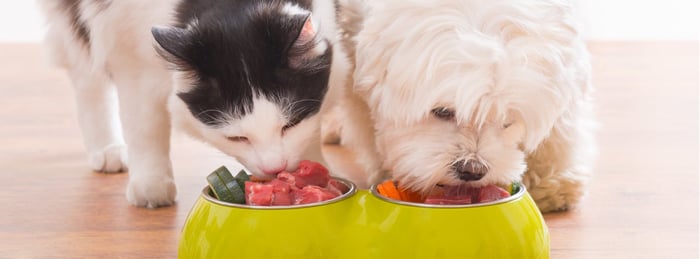Helpful Tips for Choosing a Healthy Pet Diet
Whether your pet’s main job is holding down the couch or they compete in high-energy sports, one of your priorities should be choosing a healthy pet diet that will support whatever needs they have in terms of stamina, energy, and strength.
Here are some tips for choosing a nutritious diet for your furry friend.
Look at the Ingredients List
When you look at a list of ingredients for any type of food, including pet food, the ingredients are listed from the highest to the lowest concentration in the food. For example, if the list begins with chicken, then you know that the most prevalent ingredient in the food is chicken. Look for commercial food that has a specific type of meat (beef, chicken, lamb) listed first.
If it says “meat” or “by-products,” however, you will want to steer clear.
Another red flag is if you see grain as the first ingredient. Dogs and cats both need to get their protein from meat, so that needs to be the first ingredient. Avoid any food that has artificial colors added. It simply isn’t necessary and could be bad for your pet.
Consider Wet vs. Dry Food
Many pet owners choose dry food for their pets because they think it is better for the animal’s teeth.
Though it’s true that kibble can aid in canine and feline plaque removal, it takes more to ensure your pet’s oral health.
With that being said, there are some benefits to choosing dry food:
- It keeps longer. You don’t have to worry about refrigeration once you open the package, and if it is in a bowl, it won’t become dangerous within hours. (It will get stale, so you have to change it out every 12-24 hours if it isn’t eaten, but it won’t go rancid.)
- It is usually less expensive. If you have several pets to feed and you are on a budget, dry food will usually cost less than wet.
- It is less messy and more convenient than wet food. Your pet is less likely to stain the floor or furniture with a mouthful of dry food. If you have a dog that carries food around the house, dry food might be the less messy way to go. If you travel, dry food is also more convenient.
At the same time, wet food has some of its own benefits:
- The ingredients are less processed. When you look at it, you might be able to see the bits of meat, vegetables, rice, and so on.
- Wet food provides hydration. Many pets become dehydrated either due to their habits of not drinking water or because they are ill or exercising a lot. The moisture content in wet pet food can help alleviate this dehydration. This is particularly important for cats.
- Wet food helps pets feel fuller. If your dog or cat is on the plump side, wet food is heavier in the stomach and can keep them full between feedings.
- Wet food is often more palatable. Pets that don’t have a voracious appetite or that are underweight often need to be tempted to eat. Wet food has a stronger smell and many pets find it tastier, so they are more likely to eat it.
Whichever type of food you choose, always be sure to provide plenty of fresh water to keep your pet hydrated. This is important for all pets, but especially for those that are active in sports or play hard indoors or out.
If your pet doesn’t drink water well, consider getting a pet water fountain, which creates movement and interest and might tempt your pet to drink more often.
Change the water frequently, too; once bits of food get into the water, it can taste rancid or foul and your dog or cat will avoid it.
Make Your Own Pet Food

Some pet owners prefer to make their own pet food. The advantages of making your own food include knowing exactly what is in it, knowing that it is fresh, and not having to run out to buy pet food when you notice that you are out. You can simply whip up another batch!
Getting the recipe just right can take some trial and error, but it is important that you are meeting your pet’s nutritional needs.
Talk to your veterinarian about whether your pet needs a high-protein diet (important for pet athletes), a high- or low-fat diet, and whether they can safely eat grains.
Do not put anything in the food that can be toxic to your pet. These ingredients can include onions, garlic, avocado, grapes, raisins, alcohol, cooking grease, salt, and chocolate, among others. You should also look at the nutritional guidelines for making homemade food for your dog or cat.
With a lot of different options available when it comes to choosing a healthy diet for your pet, your best bet is to talk to your veterinarian or a pet nutritionist.
This is important if your dog is participating in canine athletics, but it is also wise no matter what activities (or lack thereof) your pet is involved with.
A regular checkup will help uncover any health issues that might change what your pet needs to be eating for good health, so be sure to visit your veterinarian each year and revisit what would make a healthy diet for your particular pet and circumstances.









